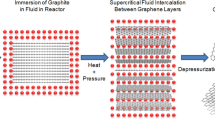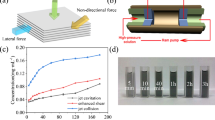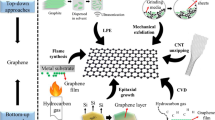Abstract
Traditional “top-down” methods for graphene preparation, like micromechanical cleavage and ultrasound methods, usually cannot preserve both efficiency and quality simultaneously. Herein, we provide an environmental-friendly graphene exfoliating method with high efficiency and high quality that combines the microfluidization process (liquid phase) and supercritical carbon dioxide process (gas phase), namely the dual-phase exfoliating (DPE) method. The combination of effective tangential force (shearing force) and normal force (push and pull), which are originally from microfluidization and supercritical carbon dioxide process, respectively, maximizes the exfoliating efficiency. The DPE method offers a high yield of up to 70.25% for graphene preparation (941.04 g per day theoretically), while the graphene sheets could remain single or a few layers (> 80%) and around micron size. By molecular dynamic simulations, it is theoretically proved that carbon dioxide can intercalate between graphite layers and expand the interlayer spacing under supercritical conditions. This DPE method, by combining the advantages of different phase processes, provides an ideal process design perspective for large-scale preparation of other 2D materials.







Similar content being viewed by others
References
Lee C, Wei X, Kysar JW, Hone J (2008) Measurement of the elastic properties and intrinsic strength of monolayer graphene. Science 321:385–388
Balandin AA, Ghosh S, Bao W, Calizo I, Teweldebrhan D, Miao F, Lau CN (2008) Superior thermal conductivity of single-layer graphene. Nano Lett 8:902–907
Xu Y, Lin Z, Zhong X, Huang X, Weiss NO, Huang Y, Duan X (2014) Holey graphene frameworks for highly efficient capacitive energy storage. Nat Commun 5:1–8
Zhang Y, Tang T-T, Girit C, Hao Z, Martin MC, Zettl A, Crommie MF, Shen YR, Wang F (2009) Direct observation of a widely tunable bandgap in bilayer grapheme. Nature 459:820–823
Lin L, Peng H, Liu Z (2019) Synthesis challenges for graphene industry. Nat Mater 18:520–524
Tao H, Zhang Y, Gao Y, Sun Z, Yan C, Texter J (2017) Scalable exfoliation and dispersion of two-dimensional materials–an update. Phys Chem Chem Phys 19:921–960
Witomska S, Leydecker T, Ciesielski A, Samorì P (2019) Production and patterning of liquid phase-exfoliated 2D sheets for applications in optoelectronics. Adv Function Mater 29:1901126
Paton KR, Varrla E, Backes C, Smith RJ, Khan U, O’Neill A, Boland C, Lotya M, Istrate OM, King P (2014) Scalable production of large quantities of defect-free few-layer graphene by shear exfoliation in liquids. Nat Mater 13:624
Arao Y, Mizuno Y, Araki K, Kubouchi M (2016) Mass production of high-aspect-ratio few-layer-graphene by high-speed laminar flow. Carbon 102:330–338
Varrla E, Paton KR, Backes C, Harvey A, Smith RJ, McCauley J, Coleman JN (2014) Turbulence-assisted shear exfoliation of graphene using household detergent and a kitchen blender. Nanoscale 6:11810–11819
Wang J, Manga KK, Bao Q, Loh KP (2011) High-yield synthesis of few-layer graphene flakes through electrochemical expansion of graphite in propylene carbonate electrolyte. J Am Chem Soc 133:8888–8891
Karagiannidis PG, Hodge SA, Lombardi L, Tomarchio F, Decorde N, Milana S, Goykhman I, Su Y, Mesite SV, Johnstone DN (2017) Microfluidization of graphite and formulation of graphene-based conductive inks. ACS Nano 11:2742–2755
Panagiotou T, Mesite S, Bernard J, Chomistek K, Fisher R (2008) Production of polymer nanosuspensions using microfluidizer processor based technologies. In: Proceedings of the nanotechnology conference and trade show, pp 688–691
Panagiotou T, Bernard JM, Mesite SV (2008) Deagglomeration and dispersion of carbon nanotubes using microfluidizer high shear fluid processors. In: Nano science and technology institute (NSTI) conference and expo proceedings, pp 39–42
Rizvi R, Nguyen EP, Kowal MD, Mak WH, Rasel S, Islam MA, Abdelaal A, Joshi AS, Zekriardehani S, Coleman MR, Kaner RB (2018) High-throughput continuous production of shear-exfoliated 2d layered materials using compressible flows. Adv Mater 30:11
Wu B, Yang X (2011) A molecular simulation of interactions between graphene nanosheets and supercritical CO2. J Colloid Interface Sci 361:1–8
Rangappa D, Sone K, Wang M, Gautam UK, Golberg D, Itoh H, Ichihara M, Honma I (2010) Rapid and direct conversion of graphite crystals into high-yielding, good-quality graphene by supercritical fluid exfoliation. Chem–A Eur J 16:6488–6494
Li L, Zheng X, Wang J, Sun Q, Xu Q (2012) Solvent-exfoliated and functionalized graphene with assistance of supercritical carbon dioxide. ACS Sustain Chem Eng 1:144–151
Zhu H, Zhang C, Tang Y, Wang J, Ren B (2007) Preparation and thermal conductivity of suspensions of graphite nanoparticles. Carbon 45:226–228
Wajid AS, Das S, Irin F, Ahmed HST, Shelburne JL, Parviz D, Fullerton RJ, Jankowski AF, Hedden RC, Green MJ (2012) Polymer-stabilized graphene dispersions at high concentrations in organic solvents for composite production. Carbon 50:526–534
Xu S, Xu Q, Wang N, Chen Z, Tian Q, Yang H, Wang K (2015) Reverse-micelle-induced exfoliation of graphite into graphene nanosheets with assistance of supercritical CO2. Chem Mater 27:3262–3272
Guardia L, Fernández-Merino M, Paredes J, Solis-Fernandez P, Villar-Rodil S, Martinez-Alonso A, Tascón J (2011) High-throughput production of pristine graphene in an aqueous dispersion assisted by non-ionic surfactants. Carbon 49:1653–1662
Santos HM, Lodeiro C, Capelo-Martinez J-L (2009) In Ultrasound in chemistry: analytical applications. Wiley, NJ
Atiemo-Obeng VA, Calabrese RV (2004) Rotor-stator mixing devices. In: Handbook of industrial mixing: science and practice. Wiley, pp 479–505
Bonaccorso F, Lombardo A, Hasan T, Sun Z, Colombo L, Ferrari AC (2012) Production and processing of graphene and 2d crystals. Mater Today 15:564–589
Paton KR, Anderson J, Pollard AJ, Sainsbury T (2017) Production of few-layer graphene by microfluidization. Mater Res Express 4:025604
Xu Y, Chen S, Dou Z, Ma Y, Mi Y, Du W, Liu Y, Zhang J, Chang J, Liang C, Zhou J, Guo H, Gao P, Liu X, Che Y, Zhang Y (2019) Robust production of 2D quantum sheets from bulk layered materials. Mater Horizons. https://doi.org/10.1039/C9MH00272C
Lotya M, Hernandez Y, King PJ, Smith RJ, Nicolosi V, Karlsson LS, Blighe FM, De S, Wang Z, McGovern IT, Duesberg GS, Coleman JN (2009) Liquid phase production of graphene by exfoliation of graphite in surfactant/water solutions. J Am Chem Soc 131:3611–3620
Zhang S-L, Zhang Z, Yang W-C (2016) High-yield exfoliation of graphene using ternary-solvent strategy for detecting volatile organic compounds. Appl Surf Sci 360:323–328
Peng L, Xu Z, Liu Z, Guo Y, Li P, Gao C (2017) Ultrahigh thermal conductive yet superflexible graphene films. Adv Mater 29:1700589
Song NN, Jia JF, Wang WC, Gao YH, Zhao YP, Chen Y (2016) Green production of pristine graphene using fluid dynamic force in supercritical CO2. Chem Eng J 298:198–205
Pu N-W, Wang C-A, Sung Y, Liu Y-M, Ger M-D (2009) Production of few-layer graphene by supercritical CO2 exfoliation of graphite. Mater Lett 63:1987–1989
Zhang J, Han B, Zhang C, Li W, Feng X (2008) Nanoemulsions induced by compressed gases. Angewandte Chemie Int Ed 47:3012–3015
Zhang J, Han B, Zhao Y, Li J, Yang G (2011) Switching micellization of Pluronics in water by CO2. Chem–A Eur J 17:4266–4272
Hernandez Y, Nicolosi V, Lotya M, Blighe FM, Sun Z, De S, McGovern I, Holland B, Byrne M, Gun’Ko YK (2008) High-yield production of graphene by liquid-phase exfoliation of graphite. Nat Nanotechnol\ 3:563
Zhu Y, Ji H, Cheng H-M, Ruoff RS (2017) Mass production and industrial applications of graphene materials. Natl Sci Rev 5:90–101
Ni ZH, Wang HM, Kasim J, Fan HM, Yu T, Wu YH, Feng YP, Shen ZX (2007) Graphene thickness determination using reflection and contrast spectroscopy. Nano Lett 7:2758–2763
Meyer JC, Geim A, Katsnelson M, Novoselov K, Obergfell D, Roth S, Girit C, Zettl A (2007) On the roughness of single-and bi-layer graphene membranes. Solid State Commun 143:101–109
Warner JH, Rümmeli MH, Gemming T, Büchner B, Briggs GAD (2009) Direct imaging of rotational stacking faults in few layer grapheme. Nano Lett 9:102–106
Parvez K, Wu Z-S, Li R, Liu X, Graf R, Feng X, Mullen K (2014) Exfoliation of graphite into graphene in aqueous solutions of inorganic salts. J Am Chem Soc 136:6083–6091
Park JS, Reina A, Saito R, Kong J, Dresselhaus G, Dresselhaus MS (2009) G′ band Raman spectra of single, double and triple layer grapheme. Carbon 47:1303–1310
Ferrari AC, Basko DM (2013) Raman spectroscopy as a versatile tool for studying the properties of grapheme. Nature Nanotechnol 8:235
Punckt C, Muckel F, Wolff S, Aksay IA, Chavarin CA, Bacher G, Mertin W (2013) The effect of degree of reduction on the electrical properties of functionalized graphene sheets. Appl Phys Lett 102:023114
Drewniak S, Muzyka R, Stolarczyk A, Pustelny T, Kotyczka-Morańska M, Setkiewicz M (2016) Studies of reduced graphene oxide and graphite oxide in the aspect of their possible application in gas sensors. Sensors 16:103
Yang D, Velamakanni A, Bozoklu G, Park S, Stoller M, Piner RD, Stankovich S, Jung I, Field DA, Ventrice CA Jr (2009) Chemical analysis of graphene oxide films after heat and chemical treatments by X-ray photoelectron and Micro-Raman spectroscopy. Carbon 47:145–152
Johnston K, Harrison K, Clarke M, Howdle S, Heitz M, Bright F, Carlier C, Randolph T (1996) Water-in-carbon dioxide microemulsions: an environment for hydrophiles including proteins. Science 271:624–626
Zhuo S, Huang Y, Peng C, Liu H, Hu Y, Jiang J (2010) CO2-induced microstructure transition of surfactant in aqueous solution: insight from molecular dynamics simulation. J Phys Chem B 114:6344–6349
Munson BR, Young DF, Okiishi TH (2006) Fundamentals of fluid mechanics. Wiley, USA
Yi M, Shen Z (2015) A review on mechanical exfoliation for the scalable production of grapheme. J Mater Chem A 3:11700–11715
Zhang J, Han B (2012) Supercritical or compressed CO2 as a stimulus for tuning surfactant aggregations. Acc Chem Res 46:425–433
Qi Y, Xu Q, Wang Y, Yan B, Ren Y, Chen Z (2016) CO2-induced phase engineering: protocol for enhanced photoelectrocatalytic performance of 2d MOS2 nanosheets. ACS Nano 10:2903–2909
Jorgensen WL, Maxwell DS, Tirado-Rives J (1996) Development and testing of the OPLS all-atom force field on conformational energetics and properties of organic liquids. J Am Chem Soc 118:11225–11236
Hess B, Kutzner C, Van Der Spoel D, Lindahl E (2008) GROMACS 4: algorithms for highly efficient, load-balanced, and scalable molecular simulation. J Chem Theor Comput 4:435–447
Konatham D, Striolo A (2008) Molecular design of stable graphene nanosheets dispersions. Nano Lett 8:4630–4641
Span R, Wagner W (1996) A new equation of state for carbon dioxide covering the fluid region from the triple-point temperature to 1100 K at pressures up to 800 MPa. J Phys Chem Ref Data 25:1509–1596
Berendsen HJP, van Gunsteren WF, DiNola A (1984) J Haak Molecular dynamics with coupling to an external bath. J Chem Phys 81:3684–3690
Essmann U, Perera L, Berkowitz ML, Darden T, Lee H, Pedersen LG (1995) A smooth particle mesh Ewald method. J Chem Phys 103:8577–8593
Astrakas LG, Gousias C, Tzaphlidou M (2012) Structural destabilization of chignolin under the influence of oscillating electric fields. J Appl Phys 111:074702
Hess B, Bekker H, Berendsen HJ, Fraaije JG (1997) LINCS: a linear constraint solver for molecular simulations. J Comput Chem 18:1463–1472
Van Gunsteren WF, Berendsen HJ (1988) A leap-frog algorithm for stochastic dynamics. Mol Simul 1:173–185
Acknowledgements
This work was supported by the National Natural Science Foundation of China [Grant 51875549, 51935012, 51935006]; the Youth Innovation Promotion Association of Chinese Academy of Sciences [2018457]; and the Key Research Program of Frontier Science, Chinese Academy of Sciences [Grant QYZDJ-SSW-SLH056].
Author information
Authors and Affiliations
Corresponding author
Ethics declarations
Conflict of interest
The authors declare that they have no conflict of interest.
Additional information
Handling Editor: Dale Huber.
Publisher's Note
Springer Nature remains neutral with regard to jurisdictional claims in published maps and institutional affiliations.
Supplementary information
Below is the link to the electronic supplementary material.
Rights and permissions
About this article
Cite this article
Zhang, N., Zhang, Y., Duan, C. et al. Supercritical CO2-assisted microfluidization as ultra-high efficiency strategy for graphene preparation. J Mater Sci 56, 15653–15666 (2021). https://doi.org/10.1007/s10853-021-05903-4
Received:
Accepted:
Published:
Issue Date:
DOI: https://doi.org/10.1007/s10853-021-05903-4




